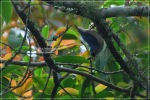Well-known for their habit of descending tree trunks head-first, as well as climbing them, the nuthatch family comprises a single genus (Sitta) of 27 species that are spread across much of the Northern Hemisphere, but are conspicuously absent from the southern continents. Only two species have colonized Indonesia from the mainland, and although both are found in Java, neither occurs in Bali, let alone on the other side of Wallace’s Line. Like the closely-related tits, which are also largely restricted to the Northern Hemisphere, nuthatches are omnivorous, feeding primarily on insects, but also on nuts and seeds, especially during the cold winter months in the temperate zone. As with the tits, nuthatches nest in tree holes, and sometimes store and hide seeds in crevices for later retrieval. They have a characteristic dumpy appearance due to the short tail and legs, but the toes are equipped with strong claws to prevent them from falling off trunks and branches while jerkily hopping up or down tree trunks and along branches, top and bottom, the latter while upside-down. Their pointed, somewhat wedge-shaped bill is used to probe crevices and pry off flakes of bark to expose prey, but occasionally these birds will hold a piece of bark and use it, as a tool, to access grubs hidden deeper in the wood.
Two species occur on Java, but one, the Blue Nuthatch (S. azurea), does not occur in Baluran as it is a montane specialist, rarely occurring below 900 metres above sea-level.
Flight: Several rapid wingbeats with short glides. Often with voice producing.
- Munguk Beledu | Velvet-fronted Nuthatch | Sitta frontalis
- Munguk Beledu | Velvet-fronted Nuthatch | Sitta frontalis
- Munguk Beledu | Velvet-fronted Nuthatch | Sitta frontalis
- Munguk Loreng | Blue Nuthatch | Sitta azurea
- Munguk Loreng | Blue Nuthatch | Sitta azurea
- Munguk Loreng | Blue Nuthatch | Sitta azurea
- Sitta azurea






